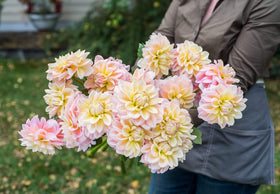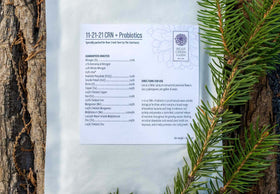Growing dahlias in summertime creates unique challenges. Excessive heat is but one. Effectively strategizing to innovate, experiment, and offer solutions is as important an exercise as any - even as the (nutrient-rich ground) shifts under us. T.S. Eliot wrote, “or us there is only the trying”. Dahlia season is upon us. The light changes, the evenings hasten, a bit. The world will soon, be awash, vibrant - in color.
Hearty gardeners “get” the importance of trying. They soldier on, trowels in hand - willing to roll up their sleeves and get their hands dirty. Intrepid, they press on through heat waves, rain, drought - as they train their energy to the hope and majesty of late summer and early fall. For it is during these weeks of (waning) summer that dahlias explode in their myriad color, and singular petal texture - a kind of summer snowflake – each one a miracle, each one unique from the next.
Dahlias are native to mountain ranges in Mexico and Central America, where temperatures range from the mid-80’s to the mid-60’s. In the United States, similar conditions have historically existed in the Pacific Northwest, although recent conditions there have shifted somewhat.
Peaches 'n' Cream dahlia
At Bear Creek Farm, we know something about tending dahlias in heat. We learn from our mistakes just as we learn from our successes. We love nothing more than to share information with our friends.
When temperatures hit 90 degrees Fahrenheit, dahlias stop growing. Dahlias may not flower when temperatures become too high. If your dahlias appear not to be flowering, do not despair. They will bloom when the temperatures fall. As you persist, look for signs of stress which can include misshapen flowers and increased susceptibility to pests and disease. Once signs of stress are apparent do not give up. It is important to fertilize the plants with low or no-nitrogen organic fertilizer.
Though counterintuitive, dahlias do their best and fastest growing in the absence of light. The scientific reason for this is that plant phytochromes detect darkness, encourage growth hormone production and cause dahlias to elongate in search of light. The greatest growth occurs right before dawn using stored glucose that occurs in photosynthesis as food. Nutrients are converted into food necessary for cell production. This is why dahlias grow best in the dark before the dawn. We get the science, but we kind of love the metaphor inherent in a flower that grows strong in darkness. (Gardeners in search of a kind of poetic beauty about the concept of resilience can take a minute to pause on this point.)
Water deeply, less frequently. Drought and heat are a double whammy. If rainfall is insufficient, we recommend watering your dahlias deeply three times a week, rather than watering them lightly daily. Misting is also a terrific way to deliver moisture when temperatures soar. Professional growers in hot climates use automated and timed hydration systems. Gardeners looking to tend their small backyard operations can use a watering wand to mist their beds several times a day in peak heat.
Create proper drainage. When you are watering your dahlias, ensure that you have adequate drainage. Without drainage you may inadvertently create conditions wherein too much water gathers and your tubers rot.
Dahlia growing in warm states. For dahlia farmers in warmer states, there are dahlia varietals we recommend because they are more heat tolerant. Gardening and growing are processes by which we can all learn and grow, both literally and figuratively. We welcome your insights, and we invite you to comment about your experiences.
Now that you've finished reading this article, you should check out our tulip planting primer, dahlia growing guide, and cutting guide for dahlias. And if you're shopping for dahlia tubers, make sure to check out our giant dahlia tubers (10"+ blooms), micro dahlia tubers (under 2" blooms), dark pink dahlia tubers, dark red dahlia tubers, and bicolor dahlia tubers.






Fascinating article. I did not know that Dahlias grow “best and fastest in the absence of light.” There is something poetic about that metaphor. Plants and people can thrive in the shadows and dappled light. We don’t have to be reality tv stars that need artificial light from sun tanning beds – if you get the drift.
Thank you for this info! I’m interested in these flowers but I’ve never grown a flower in my life lol! This will probably be above my capabilities but I’d like to give it a try. I’m mostly concerned about the best soil to grow them in because I live in Florida and it’s mostly sand!
Very helpful…Thank You!!
These tips are great, keep it up.
Thank you for this helpful information!